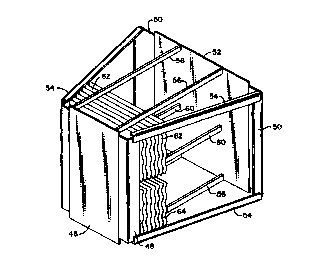Some of the information on this Web page has been provided by external sources. The Government of Canada is not responsible for the accuracy, reliability or currency of the information supplied by external sources. Users wishing to rely upon this information should consult directly with the source of the information. Content provided by external sources is not subject to official languages, privacy and accessibility requirements.
Any discrepancies in the text and image of the Claims and Abstract are due to differing posting times. Text of the Claims and Abstract are posted:
| (12) Patent Application: | (11) CA 2288081 |
|---|---|
| (54) English Title: | ROTARY REGENERATIVE HEAT EXCHANGER WITH MULTIPLE LAYER BASKETS |
| (54) French Title: | ECHANGEUR ROTATIF DE CHALEUR REGENERATIVE COMPORTANT DES COUCHES MULTIPLES DE PANIERS |
| Status: | Deemed Abandoned and Beyond the Period of Reinstatement - Pending Response to Notice of Disregarded Communication |
| (51) International Patent Classification (IPC): |
|
|---|---|
| (72) Inventors : |
|
| (73) Owners : |
|
| (71) Applicants : |
|
| (74) Agent: | SMART & BIGGAR LP |
| (74) Associate agent: | |
| (45) Issued: | |
| (86) PCT Filing Date: | 1998-03-13 |
| (87) Open to Public Inspection: | 1998-11-05 |
| Examination requested: | 1999-10-27 |
| Availability of licence: | N/A |
| Dedicated to the Public: | N/A |
| (25) Language of filing: | English |
| Patent Cooperation Treaty (PCT): | Yes |
|---|---|
| (86) PCT Filing Number: | PCT/US1998/004901 |
| (87) International Publication Number: | WO 1998049511 |
| (85) National Entry: | 1999-10-27 |
| (30) Application Priority Data: | ||||||
|---|---|---|---|---|---|---|
|
The modular heat exchange baskets (22) for a rotary regenerative air preheater
which normally have a single stacked array of heat exchange plates, are
constructed with heat exchange plate support bars (58, 60) intermediate the
top and bottom surface. The basket (22) then has two separate stacked arrays
of heat exchange plates (62, 64) which permits the plate material or
arrangement in the top of each basket (22) to be different from the plate
material or arrangement in the bottom. For side loaded air preheaters with
basket support gratings, the arrangement of heat exchange plates (62, 64) can
be changed without the need to move the gratings.
Des paniers modulaires (22) d'échange de chaleur pour un dispositif rotatif de réchauffement préalable d'air régénératif possédant normalement un seul ensemble empilé de plaques d'échange de chaleur, sont conçus de manière à présenter des barres de support (58, 60) de plaques d'échange de chaleur placées en position intermédiaire entre la surface supérieure et la surface inférieure. Ce panier (22) comporte, de ce fait, deux ensembles empilés séparés de plaques (62, 65) d'échange de chaleur permettant au matériau ou à la disposition des plaques au sommet de chaque panier (22) d'être différents du matériau ou de la disposition des plaques du fond. En ce qui concerne les dispositifs de réchauffement préalable d'air à chargement latéral comportant des grilles de support de paniers, on peut modifier la disposition des plaques (62, 64) d'échange de chaleur sans qu'il soit nécessaire de déplacer les grilles.
Note: Claims are shown in the official language in which they were submitted.
Note: Descriptions are shown in the official language in which they were submitted.

2024-08-01:As part of the Next Generation Patents (NGP) transition, the Canadian Patents Database (CPD) now contains a more detailed Event History, which replicates the Event Log of our new back-office solution.
Please note that "Inactive:" events refers to events no longer in use in our new back-office solution.
For a clearer understanding of the status of the application/patent presented on this page, the site Disclaimer , as well as the definitions for Patent , Event History , Maintenance Fee and Payment History should be consulted.
| Description | Date |
|---|---|
| Application Not Reinstated by Deadline | 2003-03-13 |
| Time Limit for Reversal Expired | 2003-03-13 |
| Deemed Abandoned - Failure to Respond to Maintenance Fee Notice | 2002-03-13 |
| Letter Sent | 2001-08-09 |
| Letter Sent | 2001-08-08 |
| Inactive: Cover page published | 1999-12-21 |
| Inactive: First IPC assigned | 1999-12-13 |
| Inactive: Acknowledgment of national entry - RFE | 1999-11-30 |
| Letter Sent | 1999-11-30 |
| Application Received - PCT | 1999-11-26 |
| Request for Examination Requirements Determined Compliant | 1999-10-27 |
| Amendment Received - Voluntary Amendment | 1999-10-27 |
| All Requirements for Examination Determined Compliant | 1999-10-27 |
| Application Published (Open to Public Inspection) | 1998-11-05 |
| Abandonment Date | Reason | Reinstatement Date |
|---|---|---|
| 2002-03-13 |
The last payment was received on 2001-01-03
Note : If the full payment has not been received on or before the date indicated, a further fee may be required which may be one of the following
Please refer to the CIPO Patent Fees web page to see all current fee amounts.
| Fee Type | Anniversary Year | Due Date | Paid Date |
|---|---|---|---|
| Basic national fee - standard | 1999-10-27 | ||
| Registration of a document | 1999-10-27 | ||
| Request for examination - standard | 1999-10-27 | ||
| MF (application, 2nd anniv.) - standard | 02 | 2000-03-13 | 1999-12-13 |
| MF (application, 3rd anniv.) - standard | 03 | 2001-03-13 | 2001-01-03 |
| Registration of a document | 2001-06-21 |
Note: Records showing the ownership history in alphabetical order.
| Current Owners on Record |
|---|
| ALSTOM POWER INC. |
| Past Owners on Record |
|---|
| KENT E. RITTER |